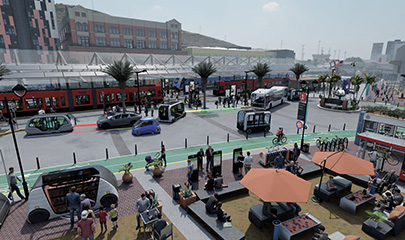SANDAG partners with local, state, regional, and federal stakeholders to plan, develop, and deploy innovative intelligent transportation system (ITS) technologies and solutions that advance the implementation of the Next OS under the adopted 2021 Regional Plan. SANDAG is bringing the Next OS vision to life through several ongoing planning and pilot efforts as described below.
Regional ITS Architecture
SANDAG recently completed a major update to the federally required Regional ITS Architecture. The Regional ITS Architecture is a tool that ensures consistency, coordination, and integration of various transportation systems across all the region's jurisdictions. It helps planners and engineers ensure that state, regional and local ITS projects can communicate and work together. As a companion to the ITS Architecture, SANDAG also completed a Transportation Systems Management and Operations Strategy that describes the operational and institutional policies and processes that will be necessary to operate the transportation system holistically.
Next Generation 511 Traveler Information System
SANDAG is also undertaking an effort to develop the concept for a new, Next Generation (NextGen) traveler information system, an expansion of the current 511 San Diego system. It is envisioned that the NextGen 511 will provide a comprehensive system that allows for seamless planning and paying for a trip involving multiple transportation services, as well as booking and paying for a trip in a single payment. NextGen 511 will explore allowing customers to request and view multiple trip itineraries and make reservations for shared-use transportation options such as transit, bike-sharing, ridesharing, and car-sharing.
Autonomous Vehicle Proving Grounds
In 2017, the San Diego Region was designated by the US Department of Transportation (DOT) as one of ten Autonomous Vehicle (AV) Proving Grounds in the nation. AV Proving Grounds were established to bring the public and private sector together to accelerate safe AV deployment on public streets and roads. Since 2017, SANDAG has been supporting Caltrans District 11, and the City of Chula Vista must collaborate with a variety of industry and academic partners in the piloting and to testing of connected and autonomous vehicle (AV) technologies in real world environments as part of the US DOT’s AV proving ground designation. These efforts have included partnering with a variety of private industry stakeholders to test 12 pilot projects throughout the region, providing real-world environments for assessing vehicles and technologies to help and prepare the region for an AV future.
Integrated Corridor Management
SANDAG was the first in the nation to demonstrate the managed lanes concept on the I-15 Express Lanes and through this partnership will have the opportunity to yet again be the first in the nation to demonstrate how the next generation of managed lanes can revolutionize roadways. The 2021 Regional Plan envisions a fully connected system of managed lanes that use technology to improve operation and performance of our existing roadways and transportation services. Managed lanes are envisioned as limited-access express lanes to provide reduced travel times and greater reliability for public transit and shared mobility services.
Advancing Border Connectivity
Implementation of several pilot Next OS solutions are currently underway through the Advancing Border Connectivity (ABC) project. In 2021, SANDAG was awarded a $9.3 million grant by the Federal Highway Administration (FHWA) under the Advanced Transportation and Congestion Management Technologies Deployment (ATCMTD) Program to establish cutting-edge technologies that will facilitate cross border travel in partnership with the private sector. SANDAG is currently working with the cities of San Diego, National City, and Chula Vista, as well as the Metropolitan Transit System (MTS), Port of San Diego, and Caltrans District 11 for project planning and design.
Next OS concepts in development include the Regional Border Management System for the new Otay Mesa East Port of Entry, connected vehicle technologies as part of the Smart Intersection System, connected vehicle technology, and Integrated Corridor Management features. Together, these strategies will expand mobility options by enhancing incident response on freeways in the border region and implementing Mobility Hub technologies like advanced traveler information services. These systems will work together to create a seamless travel experience in the border region with less car congestion, improved safety, and improved air quality. The ABC project will allow the region to quickly test these technologies and allows us to obtain lessons learned about technical, operational, and management considerations before deploying scaling up the systems across the region.
























